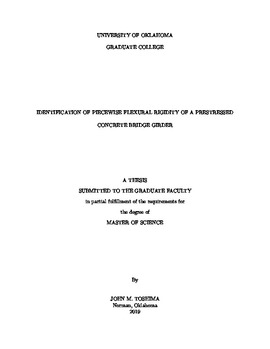| dc.description.abstract | Aging infrastructure calls for structural health monitoring for recommendations on load postings, retrofitting, or replacements. Flexural rigidity identification has been used to monitor aging precast pretensioned concrete bridge girders with suitable datasets collected from laboratory testing of a prestressed girder in previous studies. These former studies utilized classical beam theory focusing on the physical phenomenon of bending under a point load. A significant issue persisted in the previous studies' inverse problem where data analysis using the standard linear least-squares method led to negative identified flexural rigidity values. Thus, the inverse problem is completely reformulated in this study. An intuitive illustrative example is first provided for comprehension of the least-squares approach; a Bayesian analytical approach is also introduced in plain words. This approach in this study was contributed by an outside researcher, while the programming, implementation, and result analysis were performed at the University of Oklahoma in a process of learning Bayesian analysis through numerical exercises and contrasting its performance to the least-squares method. The values of critical user-defined parameters are systematically decided and thoroughly discussed to discover any limitations. Objective decisions regarding data removal are also automated through learning and exercising concepts from Computer Science. Possible idealizations of piecewise divisions are explored for their effect on model efficacy. Identified flexural rigidity values from Bayesian analysis are then compared against functional flexural rigidity values for the girder. Identifications are consistent with end region corrosion over the course of the girder's 40+ years of service-life justifying the usefulness of Bayesian analysis. This study has also led to an improved Bayesian analysis formulation. The two methodologies, previously programmed into MATLAB, were streamlined and debugged throughout this study. The original MATLAB code was used to further expand the coding suite to include numerous utility functions to expedite this study and future expansion. Validation of the code and Bayesian methodology was carried out using demonstration problems (i.e., problems with known solutions). | en_US |
